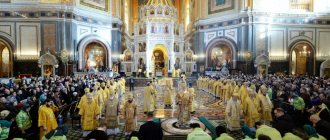Samples of notes on health and repose.
There is a category of people who go to temples only occasionally. This is due to the fact that they simply do not know how to behave in the Church. In fact, visiting this holy place does not require anything special. All you need to visit the temple is the right clothes and a positive attitude.
An unconditional ban on visiting these places is alcohol and drug intoxication. Therefore, feel free to go to church and ask the Almighty for health and prosperity for all your living relatives and peace for the dead. We will discuss how to properly submit and format health and death notes in our article.
What kind of notes to the Church are there about health and what do they look like: types, samples,
Health note No. 1
Health note No. 2
Note on health No. 3
In ancient times, there was no note on health as such. Most often, a monk or nun served at the temple, who kept a special notebook, where they wrote down the names of those for whom they should pray to God.
This was due to the fact that until the 18th century, few people knew how to write and read. But as people became more literate, special notes appeared in church use that could be filled out with one’s own hand.
As a rule, they have a memorable red border that symbolizes life. Such a note is considered one-time use, so every time you order a service about the health of your family, you will have to buy a new form.
Types of health notes:
- A simple note . The clergyman will mention the names of the people indicated in it at the usual Divine service. As a rule, this is done only once.
- Ordered note . Father ask for people’s health twice. The first time at the Divine Service, and then again during prayer before the Throne. In this case, the person asking must write the word “custom” in the upper corner of the note.
- Note on Proskomedia. It is considered the strongest of all the above. In this case, people will be asked for the health and well-being of the people at the liturgy.
- Prayer service . This type of note assumes that the clergyman will address directly the saint you have chosen. In order for him not to make a mistake, you will need to indicate the name of the Saint in the upper corner of the note (for example, a prayer service to St. Nicholas the Wonderworker).
- Annual, semi-annual commemoration. As a rule, in this case, the names of people are entered in a special book called a synodik. After filling it, it is given to the clergyman, and for 6-12 months he prays to God for the people at every service.
Andrey Szegeda: The church note is so simple and... incomprehensible?
Sometimes, the most complex and incomprehensible things in a church for us are the simplest things... For example, church notes. For me, as a person who spent more than 11 years at the altar, the question is: “What is the difference between a prayer service and a magpie?” looked funny. Until I realized that my friends and acquaintances were asking me this question too often.
Then I decided to conduct a small survey to understand what it was about church notes that my friends and colleagues did not understand, and it turned out that they did not understand literally everything!
Some wondered why the notes were written, where they were then taken, and what happened next to them and to the people for whom they were written.
Others faced the problem of filling out the note: Is it possible to enter the names of everyone or only those who are baptized? What to do if you don’t remember a person’s baptismal name? How to correctly distribute those entered into categories: “pregnant”, “soldier”, “student”, “hieromonk”, and is it even necessary?
Still others tried to understand what was the meaning of dividing notes into ordered and simple ones, magpies, prayer services and memorial services?
Finally, the fourth were concerned about the money issue. What happens if the note costs 10 rubles, but there are only 8 in your pocket? Will they refuse to accept and pray? Or why in one temple they charge money for a note, and in another for each name? If I have many relatives, should I save money on their commemoration and not submit notes for all of them? I'll try to tell you about everything.
1. Why are notes written and what happens to them later?
The Savior Christ Himself said: “Truly I also say to you that if two of you agree on earth about anything they ask, it will be done for them by My Father in heaven, for where two or three are gathered in My name, there I am in the midst of them” (Matthew 18:19-20).
These words of the Lord indicate that although home prayer is of great importance, conciliar prayer in church is still more valuable and stronger, so it is very correct to visit it as often as possible and prayerfully remember your loved ones there.
When the notes are written and given to the church shop, they await the arrival of the sexton, who will take them to the altar. There they, if these are so-called “simple notes”, will be commemorated twice.
First, the priest will prayerfully remember each of your loved ones during proskomedia - a special sacred rite, when prosphora and wine are specially prepared for the offering of the Bloodless Sacrifice for all believers, during which the Holy Spirit mysteriously transforms them into the Body and Blood of Christ.
At the proskomedia, the priest, using a special knife - a “copy”, will take out from the small prosphoras exactly the same number of particles as there are names contained in the notes collected for this liturgy, while praying for each of the indicated people. In large cathedrals there are a lot of notes, so the commemoration at the proskomedia can be performed simultaneously by several priests - each with his own part of the notes.
The second time your loved ones will be remembered is at the end of the Sacrament of Communion, when the priest brings the Holy Chalice to the altar. Then he will read the prayer: “Wash away, Lord, the sins of those remembered here, with Your Honest Blood, through the prayers of the saints,” and pour into the Chalice all the particles taken out for the people remembered on this day. Through contact with the Body and Blood of Christ, all those commemorated will receive special divine help for their physical and spiritual recovery and correction of life.
If the notes that you submit are “custom”, then they will additionally pray for those remembered by you three more times: the deacon will remember them during the reading of the special litany to them, then the priest will read a prayer before the altar, and then, depending on the “about” “health” this note or “about repose”, it will be read again with prayer, respectively, at a prayer service or at a memorial service.
2. Who can and cannot be included in the notes, when is it best to submit them and how to format them correctly?
It is best to submit notes at the evening service or at the very beginning of the liturgy, at least before the reading of the Gospel, since the priest must still have time to remember your loved ones, then prepare the Holy Gifts for transfer from the altar to the throne and, during the Great Entrance, move them there, after why the particles are no longer removed.
During divine services, the Church commemorates all people in general prayers (“... Let us pray to the Lord for those who sail, travel, are ill, suffer, and are captives, and for their salvation...”, etc.), but the commemoration by the priest in the altar is reserved for the faithful children of the Church - that there are baptized people. Also, when talking about the deceased, people who deliberately took their own lives are not remembered. The Church prays for everyone else.
It is recommended to write the names of those commemorated in the genitive case (about the health/repose of whom? - Nicholas, Elena, Pavel,..) and in full (Nicholas, not “Kolya”, Peter, not “Petya”). You should also try to write names accepted in the church tradition (Elena, not Alena, Sergius, not Sergei, George, and not Zhora, Gera, Yegor or Yuri). In this case, the person’s baptismal name is indicated (Vladlen, Arthur or Oktyabrina definitely have a second name given at Baptism).
Now about the titles. If we talk about the oldest tradition, then no titles other than holy orders were indicated in the notes. All names were written one under the other, in a column, and only clergy had some kind of prefix before their name: “Metropolitan.” - metropolitan, "bishop" - bishop, "hierome." - hieromonk, “deac.” - deacon, "mon." - monk.
Somewhat later, they began to add prefixes to the names of people requiring special prayerful commemoration - “in.” before the name of the warrior due to the severity of his service, “Jr.” - before the baby's name because of his tender age and "bol." - before the name of the sick person, because at the moment he is struggling with an illness.
Now many believers are trying to somehow single out almost everyone, and the priest is forced to spend a lot of time analyzing various fantasies like “teacher,” “fruit,” “ber,” “neg.” and others. This is not a particularly good tradition and you should not write out notes in this way.
If you still don’t remember or don’t know the name of a person in baptism, but you know for sure that he was baptized, write as it is - the priest will remember him, and the Lord knows exactly what name was given to him. But try to find out the church name of your loved one!
3. What is the meaning of separating notes and what types of notes are there?
Notes are primarily divided into two types - about the living and about the dead. They are divided into simple and custom-made because in churches, especially in large cathedrals, there can be very, very many notes and remembering all of them as custom-made can take a very long time, which delays the service and can be physically difficult for believers praying in the church, who spend the entire service carried out on their feet.
Commemorations are also divided into liturgical and non-liturgical, one-time and reusable.
At the service, only notes on health and repose (simple and custom) and church memorials are read, where relatives of priests, clergy, benefactors, etc. are written.
After the service, an additional prayer service (with or without the blessing of water, to the Lord, the Mother of God or a saint, for one or another need) or a memorial service may be served. A prayer service is served for the living, a memorial service for the dead. At the prayer service, custom-made notes about health and notes for the prayer service (with the inscription “prayer service”) are read, at the memorial service - custom-made notes about the repose and notes for the memorial service (with the inscription “requiem service”).
There are also multiple commemorations, the so-called “magpies”. They are also for the living or for the deceased and are commemorated at the same moments of divine services and extra-liturgical prayers as customized notes. The sorokousts differ only in the duration of the commemoration - they can be served for 40 days (hence the name “sorokoust”), for six months or for a year at once.
In some churches and, especially, in monasteries, you can order “eternal remembrance” or the reading of the “Indestructible Psalter.” Both for the living and for the dead. But since this does not happen everywhere, we will not consider these commemorations.
4. Money issue
Like the candle, the note is a form of our sacrifice to God and our contribution to the maintenance of the temple. In ancient times, people brought with them everything they needed for worship - bread, incense, wax, oil, wine, they themselves built a church in their village and gave a tenth of their income for its maintenance.
It is quite difficult for the current manager to make wine, and for a factory worker to collect wax from beehives... That is why we bring money to the temple and that is why in church shops there is such a seemingly Jesuitical formulation as “the recommended form of donation.”
If you don’t have enough money for baptism, or a note, everything is resolved quite simply - you just need to go to the rector of the temple, explain the situation and in the vast majority of cases he will bless you to give as much as you can and will prayerfully remember your relatives in the same way as relatives of any other person.
Finally, regarding notes and names. By this method, as a rule, they try to regulate the number of notes in churches in which there are very few priests and a lot of parishioners. In churches where everything is balanced, the amount of donation is usually calculated by the number of notes. Where the priest is overloaded, they establish a standard for names. Then the person decides who is really important to him, and for whom he can pray at home, and the priest receives some relief when remembering thousands and thousands of names. It’s also a good idea for us believers to take care of him!
Afterword
At this point, I consider the educational program dedicated to church notes to be complete. If you think that any important issue has been overlooked and you would like to address it, please write in the comments. In this case, the article will be supplemented.
Dear brothers and sisters, I hope that with the answer to some of your questions, the temple has become a little clearer and friendlier for you! Come to church more often to pray to the Lord in the company of Orthodox Christians who are unanimous in your opinion. Remember that not only you yourself need dialogue with Christ, but your living and deceased loved ones are also waiting for your prayer.
Andrey Szegeda
Dear friends! I opened my own blog! If you are interested in reading my articles, please support me by subscribing and reposting!
You can applaud the author (at least 10 times)428
Health note: who to write first?
Sample of filling out a health note
As for who should be included first in the health note, the only thing the Church insists on is that the clergy should be mentioned first (if, of course, there are such in your family). In this case, in addition to their name, their church rank must be indicated. If we talk about ordinary people, then most often those asking for them arrange them by age, starting with the oldest and ending with the youngest. Yes, you can do this, because the amount of God’s Grace that a person will ultimately receive does not depend on the place on the list.
Therefore, if you want a small child to be first on the list, then feel free to place his name in the first line. But remember that you cannot fit an infinite number of relatives into one note. Most often, such forms have either 10 or 15 separate columns. Therefore, when purchasing a ready-made note, be sure to check whether you have enough space. If you see that one is not enough for you, then fill out two at once and give them to the priest with a request to mention all your relatives in one Divine Service.
Memorial
The sample health notes provided in our article will help you fill out the form correctly. Whose names to mention in it is up to you to decide. In many families where they honor their roots, they keep a special book - a commemoration book. It contains the names of all living and deceased relatives. During the service, such little books are given for remembrance.
A memorial is a record of all the ancestors who lived in this world, who must be honored and remembered. This book must be treated with respect, cleanliness and kept near home icons. You can call it a liturgical book, because it depicts the Holy Cross, it is brought into the altar before reading, and read before the Holy Altar.
How to write names correctly in a health note: rules, example
The names in the health note are entered in the genitive case.
I would immediately like to say that the names in the note should be written in the most legible handwriting. If you write them very small and clumsily, then in the end the clergyman will not be able to read them correctly, which means the person for whom you wish well will not receive God’s Grace. Therefore, do not rush under any circumstances and write down all the letters as correctly as possible and in large handwriting if possible. Also in this case it is permissible to use large block letters.
Remember, all names must be entered in the genitive case and answer the question “who?”, for example, Vladislav, Vladimir, Lyudmila. In addition, it is worth considering that the abbreviated names we are accustomed to cannot be included in the health note. If in everyday life you call your loved one Sasha, then you will need to enter the full name Alexander in the note. Ideally, priests advise using the church names given to people at baptism for requests for health. Therefore, it will be better if you find out what the church name sounds like and write it down in the note.
How to write a note about the health of a child, a virgin, a pregnant woman?
Recommendations for writing health notes for pregnant women and children
As you probably already understood, health notes must be submitted taking into account certain rules. Thus, they never indicate the person’s last and patronymic names, as well as the degree of relationship. This is due to the fact that God already knows who is related to whom, and therefore there is no need to clarify this in the petition. The only thing you have to remember is that there are certain designations for children and women. So, for example, children under 7 years old should be mentioned in notes as infants (baby Sergius).
Children from 7 to 14 years old are called adolescents, so they must be entered in negative in the note. Evgenia. Before the name of a pregnant woman you need to put the word non-idle or fruit-bearing, and then the Almighty will know that you are asking not for one, but two people. In the case of pregnant women, it is best to order a special prayer service and contact a specific Saint. This could be the Tikhvin Icon of the Mother of God or Saints Peter and Fevronia. We mentioned how to properly format such notes a little higher.
How to write a note to Xenia the Blessed about health?
A note from Ksenia the Blessed about health
Initially, I would like to say that Ksenia the Blessed, or as she is also called St. Petersburg, is a very strong Saint and if you turn to her correctly, she will be able to solve quite a lot of problems. People ask her for improved health, complete healing of soul and body, a happy marriage and, of course, children.
Therefore, most people with great hope come to the chapel in which she is buried and pray to her for help. In order to contact Xenia the Blessed you do not need a special form. You can write a note on a regular piece of white paper, just make it as sincere as possible.
Tips for writing a note:
- First, from the bottom of your heart, pray to God and the Holy One
- It is best to start your appeal with the words Xenia the Blessed or Xenia of Petersburg
- Next, in legible handwriting, describe your request (to restore health or to heal from a serious illness)
- Then write down the full names of the people you are asking for on the note.
- At the end of your petition, be sure to write the word Amen, and once again from the bottom of your heart pray to God and Blessed Xenia herself
- After this, the note can be taken to a specially designated place for receiving such requests.
How to submit a health note correctly?
A health note is submitted at the church shop.
After the health note is filled out, according to all church rules, you will need to give it back. As a rule, this is done in a church shop, where special forms are purchased. Most often, a simple parishioner sits there and helps the priest. She collects notes throughout the first half of the day and gives them to the clergyman before the service itself.
Some churches have special places where you can leave notes about your health. The person simply leaves them there and, after praying, leaves. Every day petitions are taken from there and during the Divine service all names are necessarily read out. But remember, in order for your request to be received correctly, you must submit it, adhering to certain rules.
You should always ask for health to your loved ones with a calm soul and pure thoughts. In addition, do not forget that turning to God while drunk is considered a great sin. Therefore, if possible, avoid drinking alcohol completely 3 days before going to church.
For whom can you submit notes in church, and for whom can you not?
Notes of health and repose are submitted exclusively for baptized people.
The Church adheres to strict rules in terms of for whom notes of health and repose can be submitted, and for whom not. According to church canons, you can only ask for baptized people of all ages. If a person is baptized, it means he has a Guardian Angel, who will convey all people’s prayers to God.
But no church will pray for people who have not undergone baptism. The clergy argues that the person has not received a church name, which means the Almighty simply will not know to whom to send Grace.
In addition, you cannot submit notes for:
- An unborn child (after birth, he must be baptized)
- Unbaptized suicides (you can ask for forgiveness only after receiving special permission)
- People who have been canonized as Saints (they already have God's Grace and share it with others)
Why can’t you submit notes for unbaptized people and suicides?
For the Almighty, suicides and the unbaptized are sinners.
Among ordinary people, there is an opinion that on Radonitsa one can ask for the repose of the unbaptized and suicides. In fact, this is not the case at all. The Church believes that both cannot receive forgiveness because they are sinners before God.
They consider such people to be sinners whose souls will never be able to find peace. According to God's laws, a person does not have the right to take his own life. Therefore, if he decides to take such a step, then this indicates that the suicide does not believe that the Almighty is able to help him deal with worldly problems. In addition, it is believed that such a step is taken by weak people who are unable to bring light to others.
It is believed that even after death they do not find peace, so they continue to be tormented by unresolved problems. Such people are never given a funeral service and are buried away from the rest. The only thing that clergy advise the relatives of such people is to regularly ask God for forgiveness for them in home prayers.
Why is it necessary to pray for the dead?
When a person dies, relatives hope for a good afterlife for him. But no one can say exactly where the soul of the deceased ended up. Prayer for the dead is a huge help for them. Being in another world, the deceased cannot do good deeds that could influence their fate here. But this can be done by relatives who remain on earth.
When praying for the dead, relatives, first of all, continue their relationship with them. God has no dead; Christians believe that their loved ones who have passed on to another world are alive. Orthodox Christians also believe that through prayers on earth, the Lord will forgive and have mercy on the souls of people who died in sin. You can beg a person out of hell, but you will have to try very hard to do this.
By remembering the dead, people alleviate their fate after death. You can pray at home, but it is especially important to do it in church. Prayer for peace, as well as for health (for the living) can work miracles.
What kind of notes are there for the Church about repose, what do they look like: types
Types of notes about repose
Outwardly, a ready-made note about repose is almost all similar to the form that is used for requests for a person’s health. The only difference is the black mourning edging. It is precisely by this that people who are ignorant of church rules understand which note is preferable to use.
Types of funeral notes:
- A simple note. In this case, the name of the deceased will be mentioned only once at the next service.
- Sorokoust. Prayer is considered more powerful the way it is read during the liturgy. They will ask for the deceased for 40 days in a row.
- Postal note. It is served on the day of the beginning of Lent. In this case, they will ask for the deceased until Wednesday of Holy Week.
- Memorial service . It is served on the 3rd, 9th and 40th day after death, as well as on birthdays and name days. In this case, the person asking must be present during the prayer and pray from the bottom of his heart with the priest.
How is a funeral service held at a cemetery?
Most often, people independently commemorate the deceased in a cemetery. Before this, they clean the grave and light a candle. Quietly everyone reads prayers and remembers the deceased.
It is not advisable to eat in a cemetery. This is considered an insult to the deceased. Maybe try a little kutya in memory of the soul of the deceased. All remaining food is distributed to the hungry and poor.
A person is alive as long as his memory is alive in the hearts of his family and friends. Therefore, on the anniversary of the day of his death, they gather to honor his memory. At the same time, certain traditions are observed.
This is uttering heartfelt words, reading poems and prayers. Remembering the deceased, praying for the repose of his soul, remembering with a kind word is the best thing the living can do for the deceased.
How to write a funeral note correctly, how to write names: example
Note of repose: example
A note of repose is submitted to all Orthodox baptized people who died a natural death, that is, from illness or as a result of an accident. It is also allowed to ask for reassurance from people who have been killed. If you write such a note by hand, then be sure to draw an Orthodox cross at the very top of the sheet, and place the inscription “On repose” a little lower.
After this, you can start adding names. They must be entered in the genitive case, as legibly as possible. In addition to the name, the note can indicate the regalia of the deceased, for example, a priest or a warrior (if the person is related to military service).
If you ask the Almighty about a recently deceased person, then you must write newly deceased before his name. Before the name of a person who during his lifetime deserves eternal remembrance is written the word ever-memorable. You can see an example of such a note in the picture posted slightly above.
How and when to submit funeral notes?
It is best to submit notes of repose on Parental Saturdays.
Launches of repose are submitted in the same way as a note of health, either in a church shop or in a specially designated place. It is also advisable to leave it in the first half of the day, and then the name of your loved one will be read out during the next service. As for who cannot be mentioned in such notes, then in this case it is strictly forbidden to include in them unbaptized people and atheists who did not believe in God.
All of them are terrible sinners, therefore, by writing them on the memorial sheet, you will take on part of their sin. It is best to pray for such people at home and, in order to write off their souls, give alms to everyone who wants help. It is better to submit such notes on specially designated days.
So:
- Trinity Parents' Saturday
- Meat Saturday
- Dmitrievskaya Parent's Saturday
- Day of the Beheading of John the Baptist
- Parents' Saturdays during the weeks of Lent
- Radonitsa
Main types of commemorations for the dead
The main types of commemorations look like this:
- A memorial service is a short (no more than 30 minutes) service. Where the dead are remembered. Believers ask for the forgiveness of the sins of the dead and their repose in the Kingdom of Heaven. A memorial service is usually held weekly, after the main service. In order to remember your loved one at a memorial service, you must submit a corresponding note. That’s what it’s called – a memorial service; in a note, you can usually indicate up to ten people. The memorial service is served both in the church and in the cemetery; only the priest performs the request.
- Litiya is a very short prayer rule (10 – 15 minutes), similar to a memorial service. Unlike this, any Christian can read the litia.
- Sorokoust - commemoration of the deceased for 40 days at the Liturgy. The Church commemorates on the 40th anniversary only those who received the sacraments of confession and communion during their lifetime. The lines of the priestly prayer for those who will be remembered at the liturgy contain the following words addressed to the Lord: “for them you have provided with Your honorable Blood.” If a person did not receive communion during his lifetime, he can be remembered in a different way, but not with the help of the magpie.
- Home prayer. At the end of the morning rule there is a prayer for the departed; while reading it, the Christian lists the names of relatives who have passed on to another world, asking the Lord for forgiveness of their sins and the grant of the Kingdom of Heaven.
Text of the prayer for the dead - Candle. The least expensive way to commemorate. The candle is placed on the eve - a special square table in the church on which the crucifixion is depicted. When lighting a candle for repose, the person remembering mentally lists the names of the deceased. You can use the words of a home prayer for peace by lighting a candle.
- Products for the eve. It is very good to bring food for the eve of the deceased and put it in a special basket standing next to the table for candles. It is believed that people who eat these products will remember the deceased.
- Alms. Alms given for him by relatives or friends are of great benefit to the soul of the deceased. It is not necessary to provide money in large quantities; someone needs food, clothing and other essentials. When giving, you should ask to pray for the deceased and say his name. For example: please remember the late Lyudmila.
- Eternal remembrance. This is possible only in monasteries where services are performed daily. The deceased will be entered in a special book - a commemoration book, and the inhabitants of the monastery read it every day, before the morning service, praying for all those recorded.
But the most common way of commemoration remains a note of repose.
Commemoration with food on parental Saturdays has been practiced for a long time. When getting ready for service on this day, you can take with you a bottle of vegetable oil or a package of flour (for baking prosphora) and put it on the eve.
How often can you submit notes about health and repose in the Church or Temple?
You can submit notes in the Church before any Divine service.
Many people are interested in the question of how often they can submit notes about health and repose. Some Orthodox believe that it is impossible to disturb the Almighty too often, so they turn to him only if a person is sick or has already died. In fact, the church does not restrict people from submitting such notes.
In view of this, if you feel like going and asking God for your loved one, then do it. But still, the most favorable days for turning to the Almighty are considered to be birthdays and name days according to the Church Saints.
What is the difference between a simple note and a registered one?
Before you write a note for repose in a church, you need to know what they are.
A simple note can be read at the altar, but a piece for the deceased listed in it is not taken out. This is just a memorial, similar to an ordinary one at home.
When the ordered note is read, the priest takes out pieces from the prosphora for each deceased whose name is mentioned.
A customized commemoration costs more than a simple one. In the second case, the approximate donation amount is indicated for a note that lists no more than 10 names. When submitting a registered note, each name is charged separately. For example, one name costs 5 rubles, which means that for 10 names you will have to pay 50 rubles.










